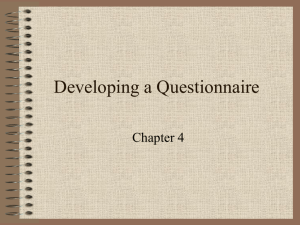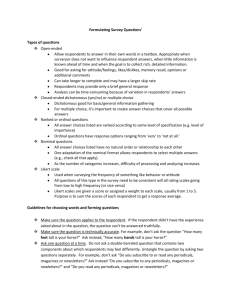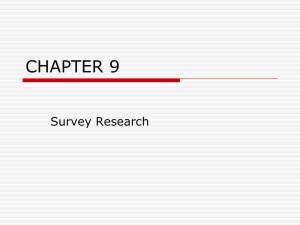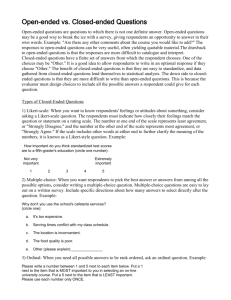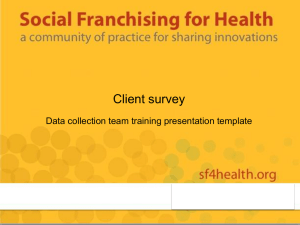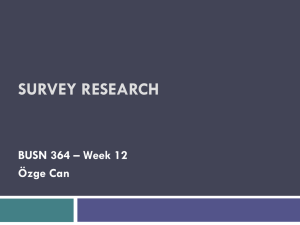Closed-ended questions
advertisement
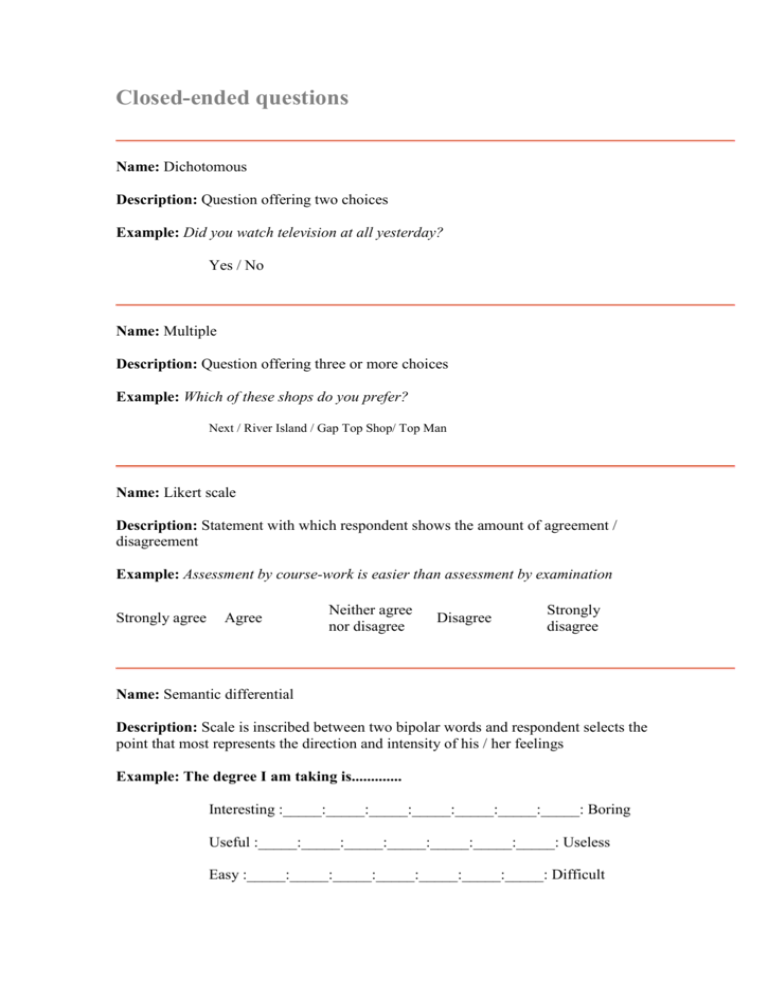
Closed-ended questions Name: Dichotomous Description: Question offering two choices Example: Did you watch television at all yesterday? Yes / No Name: Multiple Description: Question offering three or more choices Example: Which of these shops do you prefer? Next / River Island / Gap Top Shop/ Top Man Name: Likert scale Description: Statement with which respondent shows the amount of agreement / disagreement Example: Assessment by course-work is easier than assessment by examination Strongly agree Agree Neither agree nor disagree Disagree Strongly disagree Name: Semantic differential Description: Scale is inscribed between two bipolar words and respondent selects the point that most represents the direction and intensity of his / her feelings Example: The degree I am taking is............. Interesting :_____:_____:_____:_____:_____:_____:_____: Boring Useful :_____:_____:_____:_____:_____:_____:_____: Useless Easy :_____:_____:_____:_____:_____:_____:_____: Difficult Name: Rank order Description: Respondent is asked to rate or rank each option that applies. This allows the researcher to obtain information on relative preferences, importance etc. Long lists should be avoided (respondents generally find it difficult to rank more than 5 items) Example: Please indicate, in rank order, your preferred chocolate bar, putting 1 next to your favourite through to 5 for your least favourite. Double Decker Crunchie Wispa Mars Bar Creme Egg Name: Numeric Description: Respondent specifies a particular value (can include decimal places) Example: How far (to the nearest kilometre) did you travel today to reach this supermarket? ________km Open-ended questions Name: Unstructured Description: Question that respondents can answer in an unlimited number of ways? Example: Why did you enrol for this course at QMC / SCOT? Name: Word Association Description: Words are presented one at a time and respondents give the first word that comes to mind Example: What is the first thing that comes to mind when you hear the following? Lecture Interesting Computer Exam Tutorial Exciting Challenge Rewarding Name: Sentence completion Description: Incomplete sentences are presented, one at a time, and respondents are asked to complete the sentence Example: My worst shopping experience while visiting Tescburys happened when������. Name: Story completion Description: An incomplete story is presented and respondents asked to complete it Example: I sat down at the kitchen table, picked up a fork, then looked at the Chicken and Mushroom flavour Pot Noodles in front of me��. NOW COMPLETE THE STORY Advantages of Closed-Ended Questions Quick to answer Easy to code No difference between articulate and inarticulate respondents Disadvantages of Closed-Ended Questions Can draw misleading conclusions because of limited range of options Researcher / interviewer cannot deal with qualifications to responses e.g. "Yes, but�.." or "It depends" where only Yes/No are given as options Advantages of Open-Ended Questions Greater freedom of expression No bias due to limited response ranges Respondent can qualify their answers Disadvantages of Open-Ended Questions Time consuming to code Researcher / interviewer may misinterpret (and therefore misclassify) a response Question Order Your respondents may refuse to co-operate if your survey begins with awkward or embarrassing questions. People are more likely to give honest replies to personal questions if some rapport has been developed with the interviewer. For the above reasons, it is generally best to keep all questions dealing with demographic information (such as age) at the end of the questionnaire. The Layout of the Questionnaire Print clearly (if computer printout is giving faint printouts, ask the IT staff whether a new print cartridge can be installed) Allow adequate space between questions so that you can write down any comments made (but don't waste too much paper!!) Write the questions themselves in lower case (i.e. like this writing) , INSTRUCTIONS IN UPPER CASE (i.e. capital letters) Checklist for Questionnaires Before you "pilot" your questionnaire (see later section of this booklet), try going through the following checklist to spot whether any of these common mistakes apply to your own questionnaire: 1. Have you avoided all leading questions? Make sure you haven't included phrases like "Wouldn't you say that�.." or "Don't you agree that��.." 2. Is the question as specific as possible? Avoid using words like "occasionally", "regularly", "often", "in this area". If you were to ask respondents how often they visit the cinema, for example, one person's idea of "regularly" may be every couple of months, which could be another respondent's idea of "occasionally" and another person's notion of "rarely". Far better to give explicit categories such as "More than once a week" "Every week" "More than once a month" etc. 3. Are the questions going to be understood by all respondents? Avoid the two extremes of vocabulary (a) technical jargon; (b) slang or colloquialisms 4. Is each question applicable to all respondents? If not, you will need a "filtering" question first 5. Are any of your questions double-barrelled? For example: "Are your lectures and tutorials enjoyable and easy to understand?" Yes / No You may, of course, find the lectures in a subject easy but the tutorials more difficult, or you may find both easy to understand but do not enjoy them. As a bit of light relief, here is a summary of how one author suggested we deal with sensitive questions: BARTON, J A (1958) Asking the embarrassing question. Public Opinion Quarterly 22 pp.67-8 He takes as his example the delicate question of whether a respondent has murdered his wife! 1. CASUAL APPROACH "Do you happen to have murdered your wife?" 2. NUMBERED CARD APPROACH "Will you please read off the number of this card which corresponds to what became of your wife?" 3. THE 'EVERYBODY' APPROACH "As you know, many people have been killing their wives these days. Do you happen to have killed yours?" 4. THE 'OTHER PEOPLE' APPROACH "Do you know any people who have murdered their wives?" PAUSE FOR REPLY ""How about yourself?" PILOTING YOUR QUESTIONNAIRE Before you deliver any questionnaire, you should "pilot" it (i.e. test it) to check that it is going to function effectively. There are a number of reasons why it is important to pilot a questionnaire: To test how long it takes to complete To check that the questions are not ambiguous To check that the instructions are clear To allow you to eliminate questions that do not yield usable data Ideally it should be piloted on a group similar to the one that will form the population of your study. It is difficult to give an exact number for the pilot group, but as a rule of thumb, try to pilot on about 5-10% of your final sample number. The results from the pilot study, however, should not be included with your final results. If respondents omit certain questions, you should be able to find out why. Ask your "guinea pigs" the following questions: 1. 2. 3. 4. 5. 6. How long did it take to complete? Were the instructions clear? Were any questions unclear or ambiguous? Did you object to answering any questions? Was the layout clear and attractive? Any other comments? You should then alter your questionnaire to take account of comments made in the pilot study.
